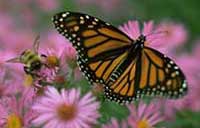數週前,當聯邦政府把遊隼(peregrine falcons)從瀕臨絕種生物的名單中剔除時,我正在野外觀察第一批正飛經沙漠,遷移到墨西哥的帝王蝶。我看到帝王蝶和牠們居家型的表親 - 一種被稱為「皇后」的蝴蝶,正在西部農田與牧場的本土可愛花兒上翩然翱翔。當時我正聽著收音機,內政部長布魯斯巴比特(Bruce Babbitt)正在詳述為何能把遊隼從絕種的邊緣救回來,而這都要感謝殺蟲劑DDT的禁用,與瀕臨絕種物種法(Endangered Species Act)的強制執行。
我感到一種莫名的興奮,現在居然有1600隻DDT零污染的遊隼。然而在此同時,我也注意到了瀕臨絕種的蝴蝶現在面臨的問題與1960年代DDT尚未禁用時遊隼面臨的問題相似。目前蝴蝶面臨的威脅之一,是一種在新品種玉米的花粉上所產生的毒素。這種毒素會殺死蝴蝶幼蟲,包含聯邦政府列舉的六種瀕臨絕種蝴蝶,以及帝王蝶(其驚人的遷徙行為被視為一種快要絕種的現象),而牠們是依賴繁茂的玉米田邊緣的馬利筋屬(milkweed)植物而生。
這些有毒花粉來自於被稱為「BT corn」的數種經基因工程改造的玉米。美國心臟地區在今年夏天(1999年)有超過二千萬英畝的土地都在種植這些玉米。農化工廠聲稱BT corn拯救了農民,因為這些玉米能抗數種害蟲,包括歐洲與西南玉米蛀蟲,避免產量損失。但是,雖然BT corn能暫時抑制住這些害蟲,農民與野生動物還是要為此付出相當高的代價。 你不會從農化工廠那兒聽到這些。當康乃爾大學的科學家在今春首次確定BT corn對於帝王蝶與其他陷入危境的蝴蝶有害時,工業界的反應就和瑞秋卡森(Rachel Carson)首次大聲疾呼DDT對環境有害時工業界的反應一樣。他們說實驗室內的研究對真實世界的重要性微乎其微,他們還說帝王蝶的幼蟲幾乎不可能曝曬在BT corn的毒素之下,因為大部份的馬利筋屬植物都不生長在玉米田的裡面或周邊。
 最近我到聖路易(St. Louis)去旅行,我很懷疑住在那兒的工業宣傳人員是否曾走出戶外。在從芝加哥到聖路易這一段150英哩的路上,我看到45英哩的玉米田,那裡的馬利筋屬植物在10英呎高的玉米田內相當常見。至少在這條帝王蝶慣常遷移的通道上,毛毛蟲很容易就接觸到傾落在牠們身上的有毒花粉。
最近我到聖路易(St. Louis)去旅行,我很懷疑住在那兒的工業宣傳人員是否曾走出戶外。在從芝加哥到聖路易這一段150英哩的路上,我看到45英哩的玉米田,那裡的馬利筋屬植物在10英呎高的玉米田內相當常見。至少在這條帝王蝶慣常遷移的通道上,毛毛蟲很容易就接觸到傾落在牠們身上的有毒花粉。
農化工廠還企圖降低科學報導的可信度,這篇報導被刊登在自然雜誌(Nature magazine)上,是一篇鬆散而草率的文章。說來奇怪,工廠還試圖聘請那些發表這篇報告的科學家,來顯示它也很關心帝王蝶的安危。同時,生物科技的擁護者也發牢騷,說BT corn是挨了一頓沒有意義的罵:有毒的BT corn花粉對帝王蝶的殺傷力比殺蟲劑之類的要小得多,如果沒有BT corn,那帝王蝶的傷亡會更慘重。但到目前為止,並沒有證據指出,BT corn在市面上的出現使得玉米田中的殺蟲劑使用量顯著降低。農企業者還是如同往常一樣,把殺蟲劑販賣給農場。
在准許Monsanto 和Novartis釋出BT corn,種植在數百萬公頃的土地之前,環保署應該先咨詢美國魚類與野生動物服務處(U.S. Fish and Wildlife Service)。但現在環保暑卻沒有經過諮詢,就通過了BT corn的許可,環保署和美國農業部至少該研究CT corn對瀕臨絕種蝴蝶的影響。但他們還是不段地拖延,說他們在宣佈任何政策改變前,都要先等到農化工廠對BT corn所有權和帝王蝶的研究出現。當一位魚類與野生動物服務處的雇員提出匿名警告時,環保署還是讓BT corn這匹大野狼伺機接近母雞的巢穴。
會產生毒素的基因改造作物須要擁有和其他各式各樣殺蟲劑一樣的安全標準,更何況一些受聯邦保護的非標的性生物都會接觸到這些毒素。環保暑必須拿回BT corn的許可,直到有證據能顯示這些作物不會對瀕臨絕種的蝴蝶造成更多的危機。
我很高興遊隼已從瀕臨絕種生物名單中振翅飛翔出來,現在就讓我們來幫助這些重要的授粉者也從瀕臨絕種生物名單中剔除。
G ary Paul Nabhan是Writers on the Range (位於科羅拉多州博尼亞的高尚國家新聞服務的刊物)的投稿人。他同時也是The Forgotten Pollinators的共同作者,並在其靠近亞歷桑那州塔克森市的家園,栽種吸引蝴蝶的花園與本土食用作物。
ary Paul Nabhan是Writers on the Range (位於科羅拉多州博尼亞的高尚國家新聞服務的刊物)的投稿人。他同時也是The Forgotten Pollinators的共同作者,並在其靠近亞歷桑那州塔克森市的家園,栽種吸引蝴蝶的花園與本土食用作物。
版權歸屬 Earth Day Network,環境信託協會(謝洵怡 譯,LiLing審校)
by Gary Paul Nabhan09.10.99
A couple of weeks ago, while the federal government was removing peregrine falcons from the list of endangered species, I was out watching the first monarch butterflies migrate through the desert on their way to Mexico. I saw both the migratory monarchs and their homebody cousins, the butterflies known as Queens, hovering around the lovely flowers of a milkweed native to Western farmlands and ranchlands. And I listened to the radio as Interior Secretary Bruce Babbitt recounted the story of how peregrines bounced back from the brink of extinction, thanks to the banning of the pesticide DDT and the enforcement of the Endangered Species Act.
Peregrine falcon, happy and DDT-free.
I felt a certain elation at hearing that there are now more than 1,600 pairs of DDT-free peregrines. At the same time, I realized that endangered butterflies face threats similar to what peregrines faced in the 1960s, before DDT was banned. One threat is a toxin that can be found in the pollen of new varieties of corn. This toxin can kill the caterpillars of butterflies, including six federally listed endangered species as well as the monarch (whose spectacular migration is considered an endangered phenomenon), when they feed upon milkweed plants at the edge of blooming corn fields.
The toxic pollen comes from several new genetically engineered crops known as BT corn, planted this summer on more than 20 million acres in America's heartland. The agrochemical industry claims that BT corn can save farmers from suffering losses caused by several crop pests, including the European and Southwestern corn borers. But though BT corn is temporarily effective in repelling these pests, it does so at a high price to both farmers and wildlife.
You wouldn't know that from listening to the agrochemical industry. When scientists from Cornell University first confirmed that BT corn poses a real threat to monarchs and other imperiled butterflies this spring, the industry responded in much the same way it did when Rachel Carson shouted the first warning cries about DDT. It claimed that lab studies had little significance in the real world and that monarch caterpillars would hardly be exposed to the BT corn toxins because most milkweeds do not grow in or near cornfields.
Pollinating pals.
On a recent trip to St. Louis, I wondered if the industry's publicists who live there ever go outside. Over a 150-mile stretch between Chicago and St. Louis, I saw 45 miles of cornfields where milkweeds were extremely common within 10 feet of the corn itself. At least along this one corridor frequented by migratory Monarchs, caterpillars can be easily exposed to the toxic pollen raining down on them.
The agrochemical industry has also tried to discredit the scientists' report, which was published in Nature magazine, as sloppy work. Curiously, it then attempted to hire some of the same scientists who published the report, announcing that it took concerns about monarchs seriously. At the same time, biotechnology advocates whined that BT corn was being given a bum rap: Toxic BT corn pollen kills far fewer monarchs than what pesticides would kill if BT corn were not available, they said. But to date, there is no indication that the presence of BT corn in the field corn market has markedly reduced the total amount of pesticides being dowsed on field corn. It is agribusiness as usual down on the corporate farm.
The EPA should have consulted with the U.S. Fish and Wildlife Service long before permitting Monsanto and Novartis to release BT corn for planting on millions of acres. Now that the cat is out of the bag, the EPA and the U.S. Department of Agriculture should at least conduct their own field studies of BT corn's effects on endangered butterflies. But they continue to stonewall, saying they are waiting for the agrochemical industry's proprietary studies of BT corn and monarchs before they announce any policy changes. As one Fish and Wildlife Service employee anonymously warned, the EPA is letting the wolves tend the hen house.
Crops genetically engineered to produce toxins require as much scrutiny as do other kinds of pesticides, especially when some of the non-target organisms exposed to them are federally protected. The EPA must be urged to suspend permits for BT corn until it can show that the crops do not pose additional risks to endangered butterflies.
I'm glad the peregrine falcon has soared off the endangered species list. Now let's help our magnificent pollinators do the same.
Gary Paul Nabhan is a contributor to Writers on the Ranger, a service of High Country News, based in Paonia, Colo. He is co-author of The Forgotten Pollinators and grows butterfly-attracting gardens and native food crops at his home near Tucson, Ariz.






